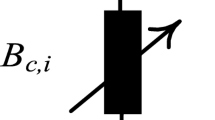Abstract
Voltage deviation and stability constrained VAr planning or reactive power planning (RPP) is an important challenging issue in power systems. This paper presents a new hybrid technique for modeling and solving RPP problem taking into account the static voltage stability constraint. First, the uncertain fuzzy clustering theory is employed to select new candidate VAr source locations. Then, modified gray code is applied and used to represent a series of non-uniform VAr capacity intervals at different candidate buses. Based on the new ordering of the VAr capacity intervals, a simplified piecewise linear function between the total transfer capability and new VAr capacity is derived and applied as static voltage stability constraint in RPP problem. Last, the RPP optimization problem is solved by a self adaptive fuzzy chaotic interactive honey bee mating optimization (FCIHBMO) technique taking advantage of the modified gray code. In the FCIHBMO algorithm, a modified definition of the updating factors on generation solution is proposed. In the case study, uncertain fuzzy clustering mechanism, the modified gray code, and the modified HBMO are applied to the IEEE 118-bus and IEEE 300-bus systems. Test results conclude that the proposed hybrid technique is a simplified and effective approach for voltage stability constrained VAr planning with contingency considered.









Similar content being viewed by others
References
Abbas R, Maziar V (2012) Optimal reactive power dispatch for improving voltage stability margin using a local voltage stability index. Energy Convers Manag 59:66–73
Ajjarapu V, Lau PL, Battul S (1994) An optimal reactive power planning strategy against voltage collapse. IEEE Trans Power Syst 9(2):906–917
Amaris H, Alonso M (2011) Coordinated reactive power management in power networks with wind turbines and facts devices. Energy Convers Manag 52(7):2575e86
Cai L-J, Erlich L (2007) Power system static voltage stability analysis considering all active and reactive power controls: singular value approach. In: Proceedings of power tech pp 367–373
Chattopadhyay D, Chakrabarti BB (2001) Voltage stability constrained Var planning: Model simplification using statistical approximation. Int J Electr Power Energy Syst 23(5):349–358
Chattopadhyay D, Chakrabarti BB (2002) Reactive power planning incorporating voltage stability. Int J Electr Power Energy Syst 24(3):185–200
Chen Y (1996) Weak bus-oriented optimal multi-objective VAR planning. IEEE Trans Power Syst 11(2):1885–1890
Chen YL, Ke YL (2004) Multi-objective Var planning for large-scale power systems using projection-based two-layer simulated annealing algorithms. Proc Inst Electr Eng Gen Trans Distrib 151(4):555–560
Christie R (2014) Power systems test case archive. http://www.ee.washington.edu/research/pstca/
Ghasemi A, Shayeghi H, Alkhatib H (2013) Robust design of multimachine power system stabilizers using fuzzy gravitational search algorithm. Electr Power Energy Syst 51:190–200
Ghasemi A (2013) A fuzzified multi objective interactive honey bee mating optimization for environmental/economic power dispatch with valve point effect. Electr Power Energy Syst 49:308–321
Ghasemi A, Khalil V, Akbar TI (2014) Multi objective optimal reactive power dispatch using a new multi objective strategy. Electr Power Energy Syst 57:318–334
Ghasemi A, Afaghzadeh H, Abedinia O, Naderi MS (2011) Artificial bee colony algorithm technique for economic load dispatch problem. In: Proceedings of EnCon2011 4th engineering conference Kuching, Sarawak, Malaysia, pp 1–6
Gray F (1953) Pulse code communication. U.S. Patent 2 632 058
Javidan J, Ghasemi A (2012) Environmental/economic power dispatch using multi-objective honey bee mating optimization. Int Rev Electr Eng 7(1):3667–3675
Khazali AH, Kalantar M (2011) Optimal reactive power dispatch based on harmony search algorithm. Electr Power Energy Syst 33:684–692
Krishnan V, Liu H, McCalley JD (2009) Coordinated reactive power planning against power system voltage instability. In: Proceedings of IEEE/PES power systems conference expo, pp 1–8
Lahacani N, Aouzellag D, Mendil B (2010) Contribution to the improvement of voltage profile in electrical network with wind generator using SVC device. Renew Energy 243e8
Liu H, Jin L, McCalley JD, Kumar R, Ajjarapu V, Elia N (2009) Planning reconfigurable reactive control for voltage stability limited power systems. IEEE Trans Power Syst 24(2):2009
Monica A, Hortensia A (2012) A multiobjective approach for reactive power planning in networks with wind power generation. Renew Energy 37:180–191
Pudjianto D, Ahmed S, Strbac G (2002) Allocation of VAR support using LP and NLP based optimal power flows. Proc Inst Electr Eng Gen Trans Distrib 149(4):377–383
Ramesha S, Kannan S (2012) Application of modified NSGA-II algorithm to multi-objective reactive power planning. Appl Soft Comput 12:741–753
Tiwari A, Ajjarapu V (2011) Optimal allocation of dynamic VAR support using mixed integer dynamic optimization. IEEE Trans Power Syst 26(1):305–314
Wang Y, Li F, Wan Q (2011) Reactive power planning based on fuzzy clustering, gray code, and simulated annealing. IEEE Trans Power Syst 26(4):2246–2255
Yorino N, Eghbal M, El-Araby EE, Zoka Y (2007) Voltage security constrained reactive power planning considering the costs and performance of VAR devices. In: Proceedings of iREP symposium on bulk power system dynamics and control–VII, pp 1–11
Zhang W, Li F, Tolbert LM (2007) Review of reactive power planning: objectives, constraints, and algorithms. IEEE Trans Power Syst 22(4):2177–2186
Zhang W, Li F, Tolbert LM (2011) Interpolation approximation of voltage stability constrained OPF (VSCOPF) for reactive power planning. Eur Trans Electr Power 21(1):155–164
Zhou S (2001) Power system voltage stability and its control. China Electric Power, Beijing
Author information
Authors and Affiliations
Corresponding author
Additional information
Communicated by V. Loia.
Rights and permissions
About this article
Cite this article
Ghasemi, A., Golkar, M.J., Golkar, A. et al. Reactive power planning using a new hybrid technique. Soft Comput 20, 589–605 (2016). https://doi.org/10.1007/s00500-014-1524-1
Published:
Issue Date:
DOI: https://doi.org/10.1007/s00500-014-1524-1




